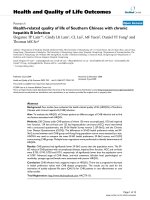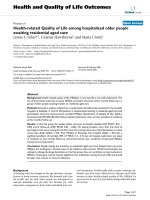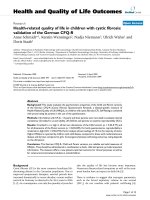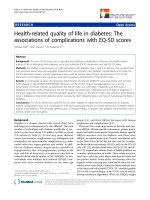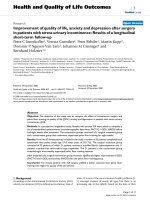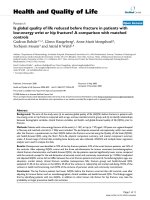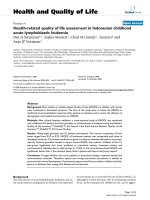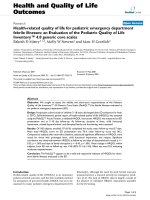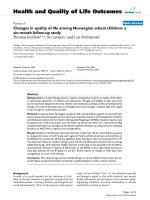Báo cáo hóa học: " No-reference image quality metric based on image classification" doc
Bạn đang xem bản rút gọn của tài liệu. Xem và tải ngay bản đầy đủ của tài liệu tại đây (1.09 MB, 11 trang )
RESEARCH Open Access
No-reference image quality metric based on
image classification
Hyunsoo Choi and Chulhee Lee
*
Abstract
In this article, we present a new no-reference (NR) objective image quality metric based on image classification. We
also propose a new blocking metric and a new blur metric. Both me trics are NR metrics since they need no
information from the original image. The blocking metric was computed by considering that the visibility of
horizontal and vertical blocking artifacts can change depending on background luminance levels. When computing
the blur metric, we took into account the fact that blurring in edge regions is generally more sensitive to the
human visual system. Since different compression standards usually produce different compression artifacts, we
classified images into two classes using the proposed blocking metric: one class that contained blocking artifacts
and another class that did not contain blocking artifacts. Then, we used different quality metrics based on the
classification results. Experimental results show that each metric correlated well with subjective ratings, and the
proposed NR image quality metric consistently provided good performance with various types of content and
distortions.
Keywords: no-reference, image quality metric, blocking, blur, human visual sensitivity
I. Introduction
Recently, there has been considerable interest in dev el-
oping image quality metrics that predict perceptual
image quality. These metrics have been useful in various
applications, such as image compression, restoration,
and enhancement. The most reliable way of eva luating
the perceptual quality of picturesisbyusingsubjective
scores given by evaluators. In order to obtain a subjec-
tive quality metric, a number of evaluators and con-
trolledtestconditionsarerequired. However, t hese
subjective tests are expensive and time-consuming. Con-
sequently, subjective metrics may not always apply. As a
result, many efforts have been made to develop objective
quality metrics that can be used for real-world
applications.
The most commonly used objective image quality
metric is the peak signal to noise ratio (PSNR). How-
ever, PSNR does not correlate well with human percep-
tion in some cases. Recently, a number of other
objective quality metrics have been developed, which
consider the human visual system (HVS). In [1] the
Sarnoff model computed errors when distortions
exceeded a visibility threshold. The structural similarity
index (SSIM) compares local patterns of pixel intensities
normalized for lumina nce and contrast [2]. One dra w-
back of these metrics is that they require the original
image as a reference.
Since human observers do not require original images
to assess the quality of degraded images, efforts have
been made to develop no-reference (NR) metrics that
also do not require original images. Several NR methods
have been proposed [3-15]. These NR methods mainly
measure blocking and blurring artifacts. Blocking arti-
facts have been observed in block-based DCT com-
pressed images (e.g., JPEG- and MPEG- coded images).
Wu et al. proposed a blocking metric (generalized block
impairment metric ( GBIM)), which employed a texture
and luminance masking method to weight a blocking
feature [3]. In [7,8], blocking metr ics were developed to
measure the blockiness between adjacent block edge
boundaries. However, these methods do not consider
that the visibility can be changed depending on back-
ground luminance levels. In [4], the blocking artifacts
were detected and evaluated using blocky signal power
and activities in the DCT domain. In [6], the blocking
* Correspondence:
Department of Electrical and Electronic Engineering, Yonsei University, 134
Sinchon-Dong, Seodaemun-Gu, Seoul, South Korea
Choi and Lee EURASIP Journal on Advances in Signal Processing 2011, 2011:65
/>© 2011 C hoi and Lee; licensee Springer. This is an Open Access article distributed under the terms of the Creative Commons
Attribution License ( which permits unrestricte d use, distribution, and reproduction in
any medium, provide d the original work is properly cited.
metric was modeled by three f eatures: average differ-
ences around the block boundary, signal activities, and
zero-crossing rates. In general, this metric requires a
training process to integrate the three features.
The blur m etric is useful for blurred images. For
example, JPEG2000 based on a wavelet transform may
produce blurring artifacts. Several NR blur metrics have
been proposed to measure smoothing o r smearing
effects on sharp edges [9-13]. Also, a blur radius esti-
mated using a Gaussian blur kernel has been proposed
to measure blurring artifacts [14,15].
However, most NR image quality metrics were
designed to measure specific distortion. As a result, they
may produce unsatisfactory performance in certain
cases. In other words, NR blocking metrics cannot guar-
antee satisfactory performance for JPEG2000 com-
pressed images and Gaussian-blurred images, w hile NR
blur metrics cannot guarantee good performance for
JPEG-compressed images. Since the HVS can assess
image quality regardless of image distortion types, ideal
NR qualit y metrics should be also able to measure such
image distortions. However, thisisadifficulttasksince
NR quality metrics have no a ccess to original images,
and we have a limited understanding of the HVS.
Recently, researchers have tried to combine blur and
blocking metrics to compute NR image quality metrics
[16,17]. In [16], Horita et al. introduced an integrate d
NR image quality metric that they used for JPEG- and
JPEG2000-compressed images. The researchers used an
automatic discrimination method of compressed images,
which produced good results for JPEG and JPEG2000
compressed images. However, the HVS characteristics
were not considered in the decision process. In [17],
Jeong et al. proposed a NR image quality metric that
first computed the blur and blocking m etrics and then
combined them for global optimization.
In this article, we propose a new NR blocking metric
and a new NR blur metric based on human visual sensi-
tivity, and we also propose a NR metric based on image
classification. The p roposed b locking metr ic was
obtained by computing the pixel differences across the
block boundaries. These difference s were computed
according to the visibility threshold, which was based on
the background luminance levels. The proposed blur
metric was computed by estimating the blur radius on
the edge regions. Images were classified based on the
proposed blocking metric. Then, the blocking metri c or
theblurmetricwasusedforeachclass.Intheexperi-
ments, the proposed NR blocking metric, NR blur
metric, and NR image quality metric based on image
classification were evaluated using three image sets (i.e.
JPEG-, JPEG2000-compressed, and Gaussian-blurred
images). In Sect. II, the proposed blocking and blur
metrics are explained, and then the image quality metric
based on image classification is presented. Experimental
results are presented in Sect. III. Conclusions are g iven
in Sect. IV.
II. The proposed no-reference image quality
metric
A. NR blocking metric calculation
In [18], Safranek showed that the visibility threshold
needs to be changed based on the background lumi-
nance. In other words, the visibility threshold may dif-
fer depending on the background luminance level. For
example, if the background luminance level is low, t he
visibility threshold generally has a relatively large
value. For medium luminance levels, the visibility
threshold is generally small. This property was used
when computing the proposed blocking metric. The
proposed blocking metric was computed using the fol-
lowing two steps:
Step 1. We computed a horizontal blocking feature
(BLK
H
) and a vertical blocking feature (BLK
V
) using
a visibility threshold of block boundaries.
Step 2. We combined BLK
H
and BLK
V
.
In order to measure the horizontal blockiness (vertical
edge artifacts), we defined the absolute horizontal differ-
ence as follows (Figure 1):
d
h
(x, y)=
Avg
L
− Avg
R
(1)
where
Avg
L
=
1
2
0
i=−1
f (x + i, y), Avg
R
=
1
2
2
i=1
f (x + i, y)
On the other hand, Chou et al. [19] defined the visibi-
lity threshold value, Ф( ⋅), as follows:
(s)=
⎧
⎪
⎨
⎪
⎩
T
0
1 −
s
L
+3 ifs ≤ L
γ (s − L)+3 ifs > L
(2)
where s represents the background luminance i nten-
sity, T
0
= 17, g = 3/128, and L =2
bit-1
-1.
In this article, min(Avg
L
,Avg
R
) was used as the back-
ground luminance value around the block boundary,
and the horizontal blockiness was only measured when
the absolute horizontal difference exceeded the v isibility
threshold as follows:
ND
h
(x)=
⎛
⎝
1≤y≤H
f (x, y) − f (x +1,y)
× u
d
h
(x, y) − (min(Avg
L
,Avg
R
)
⎞
⎠
2
(3)
where ND
h
(x) represents the sum of noticeable hori-
zontal blockiness at x and u(⋅ ) represents the unit step
function. By repeating the procedure for an entire
frame, the frame horizontal blockiness was computed as
follows:
Choi and Lee EURASIP Journal on Advances in Signal Processing 2011, 2011:65
/>Page 2 of 11
BND
h
=
⎛
⎜
⎜
⎜
⎜
⎜
⎝
1 ≤ x ≤ W
x ≡ 0(mod 8)
ND
h
(x)
⎞
⎟
⎟
⎟
⎟
⎟
⎠
1
/
2
(4)
Although we assumed that the distance between the
adjacent blocking boundaries was a multiple of 8, one
can use other values if the basic block for transforms
size is different. Also, if the video is spatially shifted,
one can determine the blocking boundaries by searching
the locations that provide the local maximum ND
h
( x)
values.
One problem with the frame horizontal blockiness
value (BND
h
) is that it may be large even though there
is no blocking artifact if the video has many vertical pat-
terns. To address this problem, we also computed the
column differences (EBD
h
) of pixels between the block-
ing boundaries and used them to normalize the BND
h
value. We computed the avera ge column difference
value EBD
h
as follows:
EBD
h
=
1
7
7
k=1
⎛
⎜
⎜
⎜
⎜
⎜
⎝
1 ≤ x ≤ W
x ≡ k(mod 8)
⎛
⎝
1≤y≤H
f (x, y) − f (x +1,y)
⎞
⎠
2
⎞
⎟
⎟
⎟
⎟
⎟
⎠
1/2
(5)
The horizontal blocking feature, BLK
H
, was computed
as follows:
BLK
H
=ln
BND
h
/EBD
h
(6)
The vertical blo cking feature BLK
V
was similarly com-
puted. The final blocking metric F
BLK
was computed as
a linear summation of the horizontal blocking feature
and the vertical blocking feature:
F
BLK
= α × BLK
H
+ β × BLK
V
(7)
In [20], it was reported that the visual sensitivities to
horizontal and vertical blocking artifacts were similar.
Therefore, a and b were set to 0.5 in this article.
B. NR blur metric calculation
The proposed NR blur metric was motivated by the
Gaussian blur radius estimator in [15], which was used
for estimating an unknown Gaussian blur radius using
two re-blurred images of the entire image. However,
blu rring artifacts are not always visible in flat (homoge-
neous) regions. They are mostly recognizable in edge
areas. Based on this observation, we divided the images
into a number of blocks, and classified each block as a
flat or edge block. Then, we computed the blur radius
only for the edge blocks. In this article, we used a blo ck
size of 8 × 8. The variance was computed at each pixel
position (x,y) as follows:
v(x, y)=
1
MN
N/2
j=−N
/
2
M/2
i=−M/2
f (x + i, y + j) − E
2
(8)
where v(x, y) represents the variance value at (x, y), M
represents the width of the window, N repr esents the
height of the window, and E represen ts the mean of the
window. In this article, M and N were set to 3. In other
words, the size of window was 3 × 3. Then, we classified
each pixel using the following equations:
Pixel type =
Flat,
Edge,
v(x, y) ≤ th
1
th
1
< v(x, y
)
(9)
x
y
RLh
AvgAvgyxd ),(
),( yxf ),1( yxf
L
Avg
R
Avg
x
y
RLh
AvgAvgyxd ),(
),( yxf ),1( yxf
L
Avg
R
Avg
Figure 1 The calculation of d
h
(x, y).
Choi and Lee EURASIP Journal on Advances in Signal Processing 2011, 2011:65
/>Page 3 of 11
In this article, the th
1
value was empirically set to 400.
Then, we classified the 8× 8 blocks based on the pixel
classification res ults. If there was at least one edge pixel
in a block, the block was classified as an edge block.
Otherwise, the block was classified as a flat block. Figure
2 shows the classification results of the Lena image. In
Figure 2, the black blocks represent flat blocks and the
white blocks represent edge blocks.
The proposed blur metric was obtained by estimating
the blur radii for the edge blocks (B
e
). The blur radius
was estimated using the procedure described in [15],
where an edge e(x) was modeled as a step function:
e(x)=
A + B, x ≥ 0
B, x < 0
(10)
where A and B are the co nstant values, and the y do
not influence the blur radius estimation.
When the edge was blurred with an unknown Gaus-
sian blur radius s, the blurred edge was modeled as fol-
lows:
b(x)=
⎧
⎪
⎪
⎨
⎪
⎪
⎩
A
2
(1 +
x
n=−x
g(n, σ )) + B, x ≥ 0
A
2
(1 −
−x−1
n=x+1
g(n, σ )) + B, x < 0
(11)
where g(n, s) represents a normalized Gaussian kernel
(
g(n, σ )=
1
√
2πσ
e
−
n
2
2σ
2
, n ∈ Z
).
To estimate the unknown blur radius s,twore-
blurred edges (b
a
(x), b
b
(x)) were obtained with the blur
radii (s
a
and s
b
(s
a
<s
b
)). Then, the difference r(x)was
calculated as follows:
r(x)=
b(x) − b
a
(x)
b
a
(x) − b
b
(x)
(12)
As proposed in [15], the blur radius s was estimated
by
σ ≈
σ
a
· σ
b
(σ
b
− σ
a
) · r(x)
max
+ σ
b
. In this article, s
a
was
empirically set to 1, and s
b
was set to 4. The blur radius
s was calculated only for the edge blocks. Finally, t he
proposed blur metric F
BLR
was obtained as follows:
F
BLR
=
1
N
B
i
σ
i
1
2
(13)
where s
i
represents the blur radius of the ith block
and N
B
represents the total number of edge blocks.
When there were no edge blocks, N
B
was zero. This
means that the entire image was highly blurred. There-
fore, in this case, F
BLR
was set to 1.
C. NR quality metric based on image classification
Jeong et al. proposed the NR image quality metric that
can be used for images with both blocking and blurr ing
artifacts [17]. Jeong et al. optimized weights for blocking
and blur metrics to compute the NR image quality
metric as follows:
QNR = v
1
× BlockingM + v
2
× BlurM
(14)
where QNR represents the NR image quality metric, v
1
and v
2
represent the weights, BlockingM represents the
blocking metric, and BlurM represents the blur metric.
On the other hand, JPEG and JPEG2000 images show
different compression characteristics [21]. JPEG images
may produce both blocking and blurring artifacts while
JPEG2000 images mainly produce blurring artifacts.
Since compressed i mages show different artifacts
depending on the employed compression standard, glo-
bal optimization may not produce the best performance.
To address this problem, we first classified the images
into two classes: one with blocking artifacts (JPEG
GG G
Figure 2 Classification results of the Lena image. Black: flat blocks and white: edge blocks.
Choi and Lee EURASIP Journal on Advances in Signal Processing 2011, 2011:65
/>Page 4 of 11
images) and the other without blocking artifacts (e.g.,
high quality JPEG imag es and JPEG2000 imag es). Then,
to compute the proposed NR quality metric, the block-
ing metric was used for images containing blocking arti-
fact s, and the blur metric was used for those containing
no blocking artifacts, respectively. The proposed block-
ing metric was used as a decision criterion, and the pro-
posed NR image quality metric was computed as
follows:
IQM
NR
=
w
1
1
+ w
1
2
× F
BLK
,
w
2
1
+ w
2
2
× F
BLR
,
F
BLK
≥ th(Blocking exists)
F
BLK
< th(No Blocking)
(15)
The weights (
w
1
1
, w
1
2
, w
2
1
,andw
2
2
) were determined by
minimizing the squared errors between the subjective
scores and NR metrics. To compute the weights
(
w
1
1
, w
1
2
, w
2
1
,andw
2
2
) in Equation 15, images were first
classified into two groups by the blocking score. The
weights (
w
1
1
and w
1
2
)werecomputedfromthesample
images that containe d the blocking artifacts, and the
other weights (
w
1
1
and w
1
2
) were computed from the sa m-
ple images that have no blocking artifacts. After the
weights were determined, the image quality metric was
computed for each case. A block diagram of the proposed
NR image quality metric is illustrated in Figure 3.
Although one may use the blocking metric along with
the blur metric for images classified as having no
blocking artifacts, we found that using the blocking
metric along with the blur metric did not improve the
performance. Similarly, although one may use the blur
metric along with the blocking metric for images classi-
fied as having blocking artifacts, it did not improve
performance.
III. Experimental results
A. Image Quality Databases and Performance evaluation
criteria
Several image quality databases (LIVE [22], IVC [23],
and TID2008 [24]) ar e publicly available. In the LIVE
database, 29 source images were used for creating 779
impaired images using JPEG images, JPEG2000 images,
Gaussian blur, white noise, and fast-fading [22]. The
LIVE database provides subjecti ve quality scores in
terms of the difference mean opinion score (DMOS).
The IVC database contains JPEG- and JPEG2000-com-
pressed images and also provides images with artifac ts
because of blurring and locally adaptive resolution
(LAR) coding [23]. The subjective quality scores are
given in terms of the mean opinion score (MOS). The
TID2008 database has 25 source images and 1700
impaired images (25 source imag es × 17 types of distor-
tions × 4 levels of distortions) [24]. The TID2008 data-
base also gives the subjective scores in terms of MOS.
In general, the evaluation of a NR quality metric is
performed by comparing the subjective MOS and
G
(No Blocking artifacts)
Input Image
Compute Distortion
Measures:
F
BLK
(Blocking metric)
F
BLR
(Blur metric)
?
thF
BLK
t
(Blocking artifacts exist)
Yes
No
BLKNR
FwwIQM
1
2
1
1
BLRNR
FwwIQM
2
2
2
1
Figure 3 Flow chart of the proposed NR metric.
Choi and Lee EURASIP Journal on Advances in Signal Processing 2011, 2011:65
/>Page 5 of 11
objective values. Since the IVC database contained a
smallnumberofJPEG2000images,weusedthe
TID2008 database as a test database. To evaluate the
proposedNRimagequalitymetric,threeimagesets:
JPEG-, JPEG2000-compressed images, and Gaussian-
blurred images were selected from the TID2008
database.
Pearson correlation coefficients were used for perfor-
mance evaluation [25]. These correlation coefficients
were computed after the 3rd order polynomial fun ctions
were applied to take into account the nonlinear relation-
ships between the objective quality metrics and the
MOS scores.
MOS
p
= β
1
+ β
2
× Metric + β
3
× Metric
2
+ β
4
× Metric
3
(16)
where b
1
, b
2
,b
3
,andb
4
represent the mapping para-
meters, Metric represents the objective quality metric,
and MOS
p
represents the predicted MOS.
B. Performance of the proposed NR blocking metric
To evaluate the proposed NR blocking metric, we used the
JPEG images of the TID2008 database and compared them
with some existing blocking metrics in the literature
[3,6,17]. Table 1 shows the Pearson correlation coefficients
Table 1 Pearson correlation coefficients between the
subjective scores and objective scores for the JPEG
compressed images (TID2008 database)
Objective metric Pearson
Proposed blocking metric 0.951
Jeong’s blocking metric [15] 0.851
Wang et al. [6] 0.954
Wu and Yuen [3] 0.924
G
(a) (b)
(
c
)
(
d
)
01234567
0
1
2
3
4
5
6
7
MOSp ( GBIM )
MOS
Pearson Correlation Coefficient = 0.924
0123456
7
0
1
2
3
4
5
6
7
MOSp ( Wang )
MOS
Pearson Correlatioin Coefficient = 0.954
01234567
0
1
2
3
4
5
6
7
MOSp ( Jeong_BLK )
MOS
Pearson Correlation Coefficient = 0.851
01234567
0
1
2
3
4
5
6
7
MOSp ( F
BLK
)
MOS
Pearson Correlation Coefficient = 0.951
Figure 4 Scatter plots of the MOS versus the MOS
p
of the blocking metrics for the JPEG images. (a) Scatter plot of GBIM (b) scatter plot
of Wang’s blocking metric (c) scatter plot of Jeong’s blocking metric (d) scatter plot of the proposed blocking metric.
Choi and Lee EURASIP Journal on Advances in Signal Processing 2011, 2011:65
/>Page 6 of 11
between the subjective scores (MOS) and the objective
scores. All the metrics showed good performa nce except
for Jeon g’s method, and the prop osed metric showed statis-
tically equivalent performance as Wang’s blocking metric,
and it was found to better than GBIM. A s seen in Fig ure 4,
the predicted MOSs (MOS
p
) of the proposed NR blocking
metrics correlated well with the subjective scores (MOS).
C. Performance of the proposed NR blur metric
The proposed NR blur metric was compared with some
existing NR blur metrics [12,13,17] using the JPEG2000
images and the Gaussian-blurred images of the TID2008
database. The performance of each metric is shown in
Tables 2 and 3. It has been reported that Ferzli’s method
produced good prediction performance wit h both image
sets (JPEG2000 and Gaussian-blurred images of LIVE
database) [ 13]. However, Ferzli’ smethoddidnotshow
satisfactory performance for the Gaussian-blurred images
of the TID2008 database. This result may have been
Table 2 Pearson correlation coefficients between the
subjective scores and objective scores for the JPEG2000
compressed images (TID2008 database)
Objective metric Pearson
Proposed blur metric 0.920
Jeong’s blur metric [15] 0.894
Ferzli and Karam [11] 0.831
Marziliano et al. [10] 0.856
Table 3 Pearson correlation coefficients between the
subjective scores and objective scores for the Gaussian-
blurred images (TID2008 database)
Objective metric Pearson
Proposed blur metric 0.800
Jeong’s blur metric [15] 0.795
Ferzli and Karam [11] 0.670
Marziliano et al. [10] 0.820
GG
(a) (b)
GG
(
c
)
(
d
)
0246
0
2
4
6
MOSp ( Marziliano )
MOS
Pearson
C
orrelatioin
C
oe
ff
icient = 0.856
0246
0
2
4
6
MOSp ( JNBM )
MOS
Pearson
C
orrelatioin
C
oe
ff
icient = 0.831
0246
0
2
4
6
MOSp ( Jeong_BLR )
MOS
Pearson Correlatioin Coefficient = 0.894
0246
0
2
4
6
MOSp ( F
BLR
)
MOS
Pearson Correlatioin Coefficient = 0.920
Figure 5 Scatter plots of the MOS versus the MOS
p
of the blocking metrics for the JPEG2000 images. (a) Scatter plot of Marziliano’s blur
metric (b) scatter plot of JNBM (c) scatter plot of Jeong’s blur metric (d) scatter plot of the proposed blur metric.
Choi and Lee EURASIP Journal on Advances in Signal Processing 2011, 2011:65
/>Page 7 of 11
caused by the fact that the test design of the TID2008
datab ase is different from that o f the LIVE database. The
proposed blur metric showed the best performance for the
JPEG2000 images and slightly lower performance than
Marziliano’s algorithm for the Gaus sian-blurred images.
This result shows that the proposed NR blur metric accu-
rately estimated the blurring artifacts for both the
JPEG2000 images and the Gaussian-blurred images. Fig-
ures 5 and 6 show the scatter plots for the JPEG2000 and
Gaussian-blurred images. The proposed blur metric corre-
lated well with the subjective scores for both image sets
(JPEG2000 and Gaussian-blurred images).
D. Performance of the proposed NR image quality metric
based on image classification
To evaluate the performance of the proposed NR image
quality metric based on image classification, three image
sets (JPEG, JPEG2000, and Gaussian-blurred images of
the TID2008 database) were combined into one set. We
first combined a blocking metric and a blur metric by
global optimization as shown in Equation 14. The block-
ing metric was either one of the existing blocking
metrics or the proposed blocking m etric. T he blur
metric was either one of the existing blur metrics or the
proposed blur metric. Table 4 s hows the NR image
quality metrics obtained as a linear combination of
some blocking and blur metrics (global optimization).
Clearly, the linear combination of the proposed blocking
and blur metrics showed the best performance.
Next, we computed the NR image quality metric based
on image classification. There was one parameter which
was the threshold value (th)inEquation15.Table5
represents the Pearson correlation coefficient of the NR
image quality metrics based on image classification as a
GG
(a) (b)
GG
(
c
)
(
d
)
0123456
0
1
2
3
4
5
6
7
MOSp ( Marziliano )
MOS
Pearson
C
orrelation
C
oe
ff
icient = 0.820
0123456
0
1
2
3
4
5
6
7
MOSp ( JNBM )
MOS
Pearson
C
orrelation
C
oe
ff
icient = 0.670
0123456
0
1
2
3
4
5
6
7
MOSp ( Jeong_BLR )
MOS
Pearson Correlation Coefficient = 0.795
0123456
0
1
2
3
4
5
6
7
MOSp ( F
BLR
)
MOS
Pearson Correlation Coefficient = 0.800
Figure 6 Scatter plots of the MOS versus the MOS
p
of the blocking metrics for the Gaussian-blurred images. (a) Scatter plot of
Marziliano’s blur metric (b) scatter plot of JNBM (c) scatter plot of Jeong’s blur metric (d) scatter plot of the proposed blur metric.
Choi and Lee EURASIP Journal on Advances in Signal Processing 2011, 2011:65
/>Page 8 of 11
function of the threshold value (th). As seen in Table 5,
when a blocking and a blur metrics were combined,
noticeably improved performance was achieved. On the
other hand, different threshold values were used for
obtaining optimal performance for different combina-
tions. Although these combinations of the blocking and
blur metrics show good results, the NR image quality
metric using the proposed NR blur and blocking metrics
showed the b est performance. Furthermore, as seen in
Tables 4 and 6, employing image classification signifi-
cantly improved performance. Figure 7 shows some
sample images that were degraded by the JPEG images,
the JPEG2000 images, and the Gaussian blur kernel.
The predicted MOSs by the proposed NR image quali ty
metric correlate well with the subjective scores.
Table 7 shows how the three image sets (JPEG,
JPEG2000, and Gaussian-blurre d images of the TID2008
database) were classified. For the JPEG database, 14% of
the images were classified as images without blocking
artifacts, 4% of the JPEG200 database were classified as
images with blocking artifacts, and 2% of the Gaussian-
blurred database were classified as images with blocking
artifacts. Table 8 shows the performance of the pro-
posed NR metric based on image classification for each
Table 4 Pearson correlation coefficient of the NR image quality metric Obtained by global optimization (TID2008
database)
Combined Images
(JPEG/JPEG2000/Gaussian Blurred)
NR metric using the proposed blocking and blur metrics 0.819
NR metric using Jeong’s blocking and blur metrics [15] 0.735
NR metric using [6,10] 0.689
NR metric using [6,11] 0.714
NR metric using [3,10] 0.740
NR metric using [3,11] 0.738
Table 5 Pearson correlation coefficient of the NR image quality metric based on image classification as a function of
the threshold value (TID2008 database)
Threshold -0.8 -0.7 -0.6 -0.5 -0.4 -0.3 -0.2 -0.1 0 0.1 0.2 0.3 0.4 0.5 0.6 0.7 0.8
NR metric using the
proposed blocking and blur
metrics
0.301 0.341 0.421 0.498 0.673 0.742 0.793 0.840 0.855 0.852 0.853 0.851 0.854 0.855 0.846 0.838 0.826
NR metric using Jeong’s
blocking and blur metrics
[15]
0.301 0.336 0.406 0.470 0.624 0.681 0.723 0.769 0.801 0.801 0.818 0.834 0.843 0.846 0.839 0.833 0.824
NR metric using [6] and
[10]
0.364 0.410 0.485 0.549 0.668 0.708 0.740 0.767 0.763 0.744 0.744 0.742 0.744 0.745 0.739 0.735 0.730
NR metric using [6] and
[11]
0.351 0.412 0.487 0.554 0.708 0.752 0.790 0.827 0.829 0.824 0.802 0.776 0.778 0.779 0.772 0.767 0.757
NR metric using [3] and
[10]
0.517 0.548 0.600 0.646 0.737 0.760 0.766 0.758 0.758 0.741 0.738 0.739 0.742 0.743 0.737 0.735 0.729
NR metric using [3] and
[11]
0.508 0.550 0.602 0.651 0.774 0.801 0.815 0.818 0.825 0.821 0.797 0.773 0.776 0.778 0.771 0.767 0.756
Table 6 Pearson correlation coefficient of the NR image quality metric based on image classification by the proposed
blocking metric (TID2008 database)
Combined images
(JPEG/JPEG2000/Gaussian blurred)
NR metric using proposed blocking and blur metrics 0.855
NR metric using Jeong’s blocking and blur metrics [15] 0.846
NR metric using [6,10] 0.767
NR metric using [6,11] 0.829
NR metric using [3,10] 0.766
NR metric using [3,11] 0.825
Choi and Lee EURASIP Journal on Advances in Signal Processing 2011, 2011:65
/>Page 9 of 11
of the t hree image sets. The proposed NR metric based
on image classification showed consistently good perfor-
mance for different impairment types. For the JPEG and
JPEG2000 databases, the performance of the proposed
NR metric based on image classification was identical to
that of the proposed NR blocking metric or the pro-
posed NR blur metric. For the Gaussian-blurred data-
base, the proposed NR metric based on image
classification performed better than the other N R blur
metrics.
Figure 7 Some sample images that were degraded by the JPEG and JPEG2000 images and the Gaussian-blurred kernel, MOSs and the
objective quality predictions (MOS
p
) obtained by the proposed NR metric.
Table 7 Classification results of the three image sets (JPEG, JPEG2000, and Gaussian-blurred images of TID2008
database)
JPEG JPEG2000 and Gaussian-blurred images
Classified as images without blocking artifacts 14% 96% 98%
Classified as images with blocking artifacts 86% 4% 2%
Choi and Lee EURASIP Journal on Advances in Signal Processing 2011, 2011:65
/>Page 10 of 11
IV. Conclusions
In this article, we proposed a new NR image quality
metric based on image classification. The NR blocking
metric was obtained by computing noticeable horizontal
and vertical distortions across block boundaries. The
NR blur metric was computed by estimating the blur
radii in the edge regions. To develop the new NR image
quality metric, images were first classified into two
classes: one that contained blocking artifacts, and the
other that contained no blocking artifacts. Then, the dif-
ferent quality metrics were used to measure the image
quality. The experimental results show that the pro-
posed NR blocking and blur metrics correlated highly
with the subjective scores and the proposed NR metric
based on image classification showed consistently good
performance.
Abbreviations
BLK
H
: horizontal blocking feature; BLK
V
: vertical blocking feature; DMOS:
difference mean opinion score; GBIM: generalized block impairment metric;
HVS: human visual system; LAR: locally adaptive resolution; MOS: mean
opinion score; NR: no-reference; PSNR: peak signal to noise ratio; SSIM:
structural similarity index
Acknowledgements
This study was supported by the IT R & D program of MKE/KCC/KEIT
[10035158].
Competing interests
This article was suppor ted by the Korea IT R&D program of MKE/KCC/KEIT
[10035158].
Received: 12 August 2011 Accepted: 18 September 2011
Published: 18 September 2011
References
1. J Lubin, D Fibush, Sarnoff JND Vision Model (T1A1.5 Working Group
Document No. 97-612, ANSI T1 Standards Committee, 1997)
2. Z Wang, AC Bovik, HR Sheikh, EP Simoncelli, Image quality assessment:
from error visibility to structural similarity. IEEE Trans Image Process. 13(4),
600–612 (2004). doi:10.1109/TIP.2003.819861
3. HR Wu, M Yuen, A generalized block-edge impairment metric for video
coding. IEEE Signal Process Lett. 4(11), 317–320 (1997). doi:10.1109/
97.641398
4. S Liu, AC Bovik, Efficient DCT-domain blind measurement and reduction of
blocking artifacts. IEEE Trans Circuits Syst Video Technol. 12(12), 1139–1149
(2002). doi:10.1109/TCSVT.2002.806819
5. Z Wang, AC Bovik, BL Evans, Blind Measurement of Blocking Artifacts in
Images, in Proc IEEE Int Conf Image Processing. 3, 981–984 (2000)
6. Z Wang, HR Sheikh, AC Bovik, No-Reference Perceptual Quality Assessment
of JPEG Compressed Images, in Proc IEEE Int Conf Image Processing,
477–480 (2002)
7. R Venkatesh Babu, AS Bopardikar, A Perkis, OI Hillestad, No-reference
Metrics for Video Streaming Applications, in Proc of International Packet
Video Workshop (December2004)
8. S Suthaharan, No-reference visually significant blocking artifact metric for
natural scene images. Signal Process. 89(8), 1647–1652 (2009). doi:10.1016/j.
sigpro.2009.02.007
9. X Li, Blind image quality assessment, in Proc IEEE Int Conf Image Processing
(2002)
10. P Marziliano, F Dufaux, S Winkler, T Ebrahimi, A No-Reference Perceptual
Blur Metric, in Proc IEEE Int Conf Image Processing. 3,57–60 (2002)
11. E Ong, W Lin, Z Lu, X Yang, S Yao, F Pan, L Jiang, F Moschetti, A No-
Reference Quality Metric for Measuring Image Blur, in Proc IEEE Int Conf
Image Processing, 469–472 (2003)
12. P Marziliano, F Dufaux, S Winkler, T Ebrahimi, Perceptual blur and ringing
metrics: application to JPEG2000. Signal Process. Image Commun. 19(2),
163–172 (2004)
13. R Ferzli, LJ Karam, A no-reference objective image sharpness metric based
on the notion of just noticeable blur (JNB). IEEE Trans Image Process. 18(4),
717–718 (2009)
14. JH Elder, SW Zucker, Local scale control for edge detection and blur
estimation. IEEE Trans Pattern Anal Mach Intell. 20(7), 699–716 (1998).
doi:10.1109/34.689301
15. H Hu, G Haan de, Low Cost Robust Blur Estimator, in Proc IEEE Int Conf
Image Processing, 617–620 (2006)
16. Y Horita, S Arata, T Murai, No-reference image quality assessment for JPEG/
JPEG2000 coding, in Proc EUSIPCO, 1301
–1304 (2004)
17. T Jeong, Y Kim, C Lee, No-reference image quality metric based on blur
radius and visual blockiness. Opt Eng. 49(4), 045001 (2010). doi:10.1117/
1.3366671
18. RJ Safranek, JD Johnston, A perceptually tuned subband image coder with
image dependent quantization and post-quantization data compression, in
Proc IEEE Int Conf, Acoust., Speech, Signal Processing. 3, 1945–1948 (1989)
19. CH Chou, YC Li, A perceptually tuned subband image coder based on the
measure of just-noticeable-distortion profile. IEEE Trans Circuits Syst Video
Technol. 5(6), 467–476 (1995). doi:10.1109/76.475889
20. SA Karunasekera, NG Kingsbury, A distortion measure for blocking artifacts
in images based on human visual sensitivity. IEEE Trans Image Process. 4(6),
713–724 (1995). doi:10.1109/83.388074
21. F Ebrahimi, M Chamik, S Winkler, JPEG vs. JPEG2000: an objective
comparison of image encoding quality. App Dig Image Proc XXVII. 5558,
300–308 (2004)
22. HR Sheikn, Z Wang, L Cormack, AC Bovik, LIVE image quality assessment
database. (2003)
23. P Le Callet, F Autrusseau, Subjective quality assessment irccyn/ivc database,
(2005)
24. N Ponomarenko, M Carli, V Lukin, K Egiazarian, J Astola, F Battisti, Color
Image Database for Evaluation of Image Quality Metrics, in Proc Int
Workshop on Multi-media Signal Processing, 403–408 (2008)
25. VQEG, Final Report from the Video Quality Experts Group on the Validation of
Objective Models of Video Quality Assessment (March 2003)
doi:10.1186/1687-6180-2011-65
Cite this article as: Choi and Lee: No-reference image quality metric
based on image classification. EURASIP Journal on Advances in Signal
Processing 2011 2011:65.
Submit your manuscript to a
journal and benefi t from:
7 Convenient online submission
7 Rigorous peer review
7 Immediate publication on acceptance
7 Open access: articles freely available online
7 High visibility within the fi eld
7 Retaining the copyright to your article
Submit your next manuscript at 7 springeropen.com
Table 8 Performance of the proposed NR metric for each
of the three image sets
JPEG JPEG2000 Gaussian-blurred images
The proposed NR metric 0.951 0.920 0.827
Choi and Lee EURASIP Journal on Advances in Signal Processing 2011, 2011:65
/>Page 11 of 11
